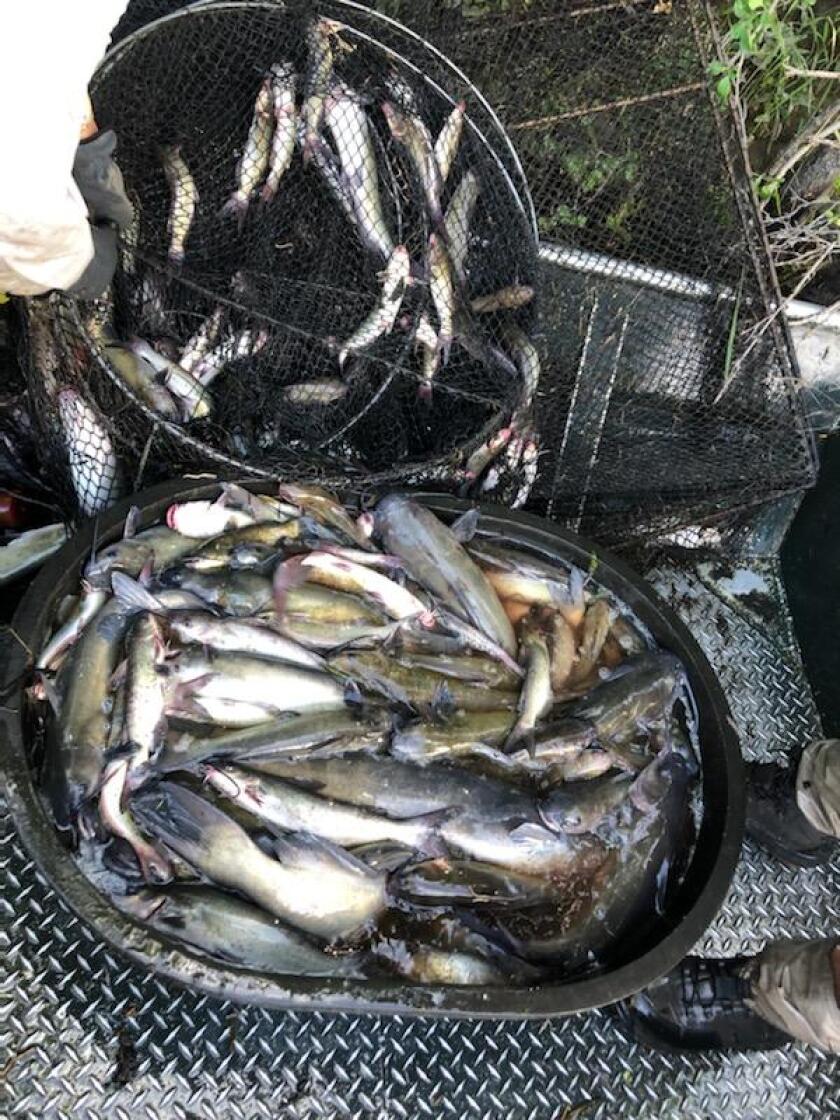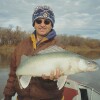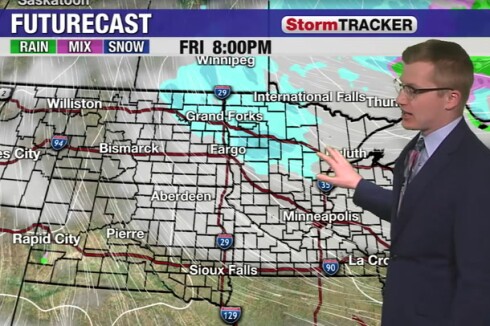GRAND FORKS – To those who don’t know any better, the Red River might seem like a muddy stream that occasionally floods and doesn’t provide much in terms of fishing opportunities.
They would be badly mistaken.
The Minnesota Department of Natural Resources, with assistance from the North Dakota Game and Fish Department, recently wrapped up a comprehensive fisheries survey on the Grand Forks portion of the Red River.
Once again, the survey revealed just how good the Red River fishery really is.
Using a combination of 30 trap nets and 18 trotlines – each with 25 baited hooks – crews set sampling gear Tuesday, June 21, and wrapped up the Grand Forks survey Friday, June 24, said Nick Kludt, Red River fisheries specialist for the DNR in Detroit Lakes, Minnesota.
ADVERTISEMENT

The Grand Forks survey begins below Riverside Dam and extends the next few miles downstream.
“Things went pretty well,” Kludt said. “We got all kinds of freshwater drum, we did really well on saugers, some nice walleyes and then – of course – quite a few catfish.”
Conducted every five years since 1990, the survey originally was scheduled for the summer of 2020 but was postponed because of the COVID-19 pandemic. Fisheries managers in 2021 opted to wait yet another year before conducting the survey.

As part of the survey, which covers the entire U.S. portion of the Red River, fisheries crews divide the river into four reaches: Wahpeton-Breckenridge to Fargo, Fargo to Grand Forks, Grand Forks to the Drayton Dam and Drayton Dam to the Manitoba border.

Fisheries crews from Fergus Falls and Detroit Lakes work the two upper reaches of the river, where sampling is limited to 30 trap nets. A crew from the DNR’s area fisheries office in Baudette, Minnesota, oversees the sampling effort from Grand Forks to the Manitoba border.
The Breckenridge portion of the survey was conducted June 13-17, and crews simultaneously sampled the Fargo and Grand Forks stretches of river last week, Kludt said.
Todd Caspers, district fisheries biologist for the North Dakota Game and Fish Department in Devils Lake, assisted in Grand Forks. North Dakota and Minnesota share management of the Red River, and the Game and Fish Department also is coordinating a creel survey this summer along the U.S. portion of the Red.
High water delay
The Red River fisheries assessment traditionally begins in early June, but high water delayed this year’s survey, Kludt said. Sampling downstream from Drayton Dam is still a couple of weeks off because of lingering high water, he said.
ADVERTISEMENT
Specifically, Kludt said the goal of the survey is to learn more about recruitment, growth rates and mortality of Red River channel catfish and whether special regulations are still working as intended to ensure “that fishery remains at the world-class quality that people expect of it.”
Anglers on the Red River can keep only one catfish longer than 24 inches in their five-fish limit.

“Secondary goals, of course, are to look at the other fish species in the river and check in on those populations as well as we can within the primary effort of looking at the channel cats,” Kludt said.
While trotlines generally catch the largest catfish, the biggest fish were somewhat elusive during this year’s Grand Forks survey, Kludt said; crews saw a similar pattern in Fargo.
“That was kind of unique,” he said. “On sonar, everyone kind of agreed that those fish were all sitting off about that 23-25 foot break out in the middle of the river. And that was a little puzzling because normally, standard river wisdom would tell you that in high flow conditions, they should be up shallow on those side seams, where they’re real vulnerable to both sampling gear and angling.
“And for whatever reason, be it a combination of flow, temperature, just environmental conditions, they were sitting out in an area where they were relatively inaccessible to sampling gear, as well as in a real negative feeding mood.”
Then – also for whatever reason – that started to change Friday, June 24, the last day of sampling in Grand Forks, Kludt said. The big fish turned on, and the trend persisted into the weekend. The Scheels Boundary Battle Catfish Tournament held Saturday, June 25, and Sunday, June 26, set records for overall tournament weights.
“Something changed environmentally,” Kludt said. “Those fish went on the feed, and the tournament was a great success.”
ADVERTISEMENT
Catfish reports from other parts of the state told a similar story.
“Even over by Brainerd, people fishing were saying, ‘Yeah, the catfishing is just lights out – it’s on fire,’” Kludt said. “(Bait is) hitting the bottom and fish are grabbing it right away. Sometimes, you’re just forced to take what the river gives you and that’s how it goes.”
Other survey highlights
Also interesting, Kludt said, was the number of freshwater drum and saugers that the crews sampled along the Grand Forks portion of the river. Crews sampled numbers of fish of varying sizes, suggesting strong production and recruitment for both species, he said.

“On the one hand, I would have liked to have seen more of those larger channel cats, but given some of the other aims of the survey, collecting numbers of sauger and freshwater drum – we achieved those goals,” he said.
One of the more fascinating findings of the survey to date occurred near Breckenridge, where the DNR crew sampled a catfish that had been tagged in Netley Marsh near Lake Winnipeg, Kludt said. A crew from the University of Nebraska-Lincoln that tagged catfish on the Manitoba portion of the Red River for several years tagged the fish in 2014 when it was about 11½ inches long, Kludt said.
The fish now measured about 17¾ inches, he said, which means it’s growing about .9 inches per year.
As the crow flies, Netley Marsh is about 275 miles from Wahpeton, and in river miles, it’s probably twice that far, Kludt said, if not more.
“Of the fish tagged in that entire study, this is one of the farthest-moving fish, and it was certainly the farthest-moving fish that headed upstream,” he said. “That’s not bad for a channel catfish that’s less than 18 inches. And it’s kind of a neat commentary on our connectivity efforts that a cat from Netley Marsh can make it all the way to Breckenridge, Minnesota.”
ADVERTISEMENT
As a river biologist, getting out on the Red River to see firsthand what’s actually swimming in the river’s murky depths is a highlight, Kludt says, but there’s also more to the picture.
“The fieldwork is extremely interesting, (but) the analysis that follows it, in many ways, is just as interesting, because then, you can actually put numbers to what you’ve seen in the field,” he said. “And then, the really fun part is communicating with anglers about how spectacular that fishery remains.”












